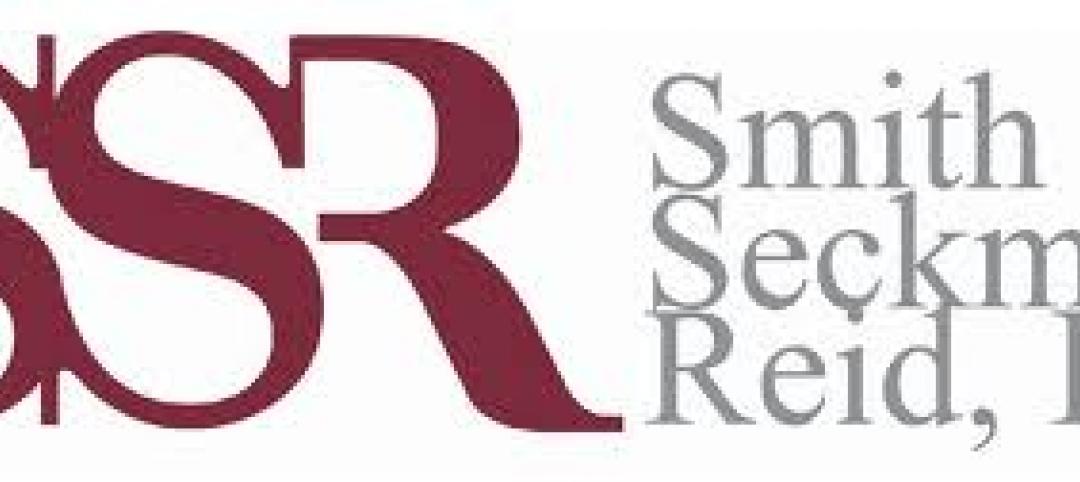Design and construction professionals who completed our flooring survey had strong opinions about their preferred flooring type. Typical responses: “Hardwood and porcelain tile are my favorites.” “I prefer carpet.” “I love polished concrete. Price, durability, ease of maintenance—need I say more?” “We have started using recycled rubber flooring and it has been a great success.” “My favorite would be integral color concrete, with options of staining, etching, and sealers or paste wax.”
“We are really sold on carpet tiles,” one respondent enthused. “Eighty percent of the wear is found on 20% of the carpet. I like replacing just 20% every 10 years.” Another respondent said, “Engineered wood looks like the real thing and performs resiliently to all scratches.” This respondent’s faves? Slate and wood: “Aesthetic, cool, and environmentally friendly.” Another’s “three best innovations”: “affordable, high-performance thin-set terrazzo, recyclable carpet, and bamboo.”
Respondents reported a problem with recent disruptions to the supply chain. “The biggest issue is getting the specified products in a timely manner, especially if they are made overseas,” said one. Another cited “availability and transportation costs.”
Maintenance issues also came up. “Many clients do not know how to maintain their floors well at minimal costs,” wrote one respondent. “On the other hand, manufacturers often present maintenance scenarios that are unreal.”
A number of respondents offered practical advice to others in the field. “Installers are a significant part of the equation,” warned one. “Always check your flooring moisture content prior to setting flooring materials,” advised one. Another piece of advice: “Always note the coefficient of friction.” Said another, “Thorough research has always preceded our flooring choices.”
WATER-BASED ADHESIVES AND CONCRETE
Several respondents wrote about the use of water-based adhesives on concrete slabs. “Although they are more eco-friendly with low VOCs, they require the concrete slab to be much drier than can typically be achieved,” said one. “This has prompted a slew of products to seal the concrete before installing the floor covering. Some of these products work and others do not. The manufacturers’ claims are typically not true and there is no standard to compare them.” This writer added that “newer adhesives have come out that can accommodate higher moisture and pH levels in the concrete. I welcome this trend as it greatly simplifies the process and creates less liability for everyone.”
Another got down and dirty on the topic of adhesion of floor coverings when vapor emissions, pH, or relative humidity values of new concrete floor slabs exceed the ranges allowed by the flooring manufacturer for a warrantable installation: “Using a reputable vapor emission control system (and our research has found that there are only a couple of systems that perform as advertised on a consistent basis) definitely helps reduce flooring failures.”
Summing up this moisture/adhesives issues, one AEC professional said, “The flooring industry must develop unified and clearly spelled-out national standards to test and accept relative humidity values. It is a mess right now. It must be thoroughly studied [and] researched, and national guidelines [must] be published.” BD+C
Major Findings of the Flooring Study
1. Ceramic tile was the runaway choice for flooring systems, with 80% of respondents using it in the past 18-24 months.
2. Other strong preferences: broadloom carpet (66%), carpet tile (65%), and VCT–vinyl composition tile and concrete/polished concrete (both 58%).
3. The four most important general factors in choosing flooring systems were initial cost, including installation (69%); durability/reliability (66%); performance/quality (61%;) and aesthetics (59%).
4. In terms of sustainability, life cycle cost/life cycle assessment (60%) and low to no VOC content (59%) finished in a virtual dead heat. Tying for third (given the 6% margin of error): LEED points or other green certification (39%) and recycled content (38%).
5. No certification program, rating system, or industry standard gained a majority of respondents. FSC certification (from the Forest Stewardship Council) for wood flooring came out on top (44%).
6. Nearly three in 10 respondents (29%) said they had no problems in choosing flooring products. Others cited such concerns as reliability of product data (31%), conflicting manufacturer claims and not enough time to research/choose products (both 29%), and false or unsubstantiated claims (28%).
METHODOLOGY
Building Design+Construction surveyed a representative sample of its subscribers via e-mail in late July 2011. An incentive of a $25 Amazon gift certificate was offered to the first 10 respondents; 258 qualified surveys were returned. The approximate margin of error: 6% at the 95% confidence level.
Table 1.
Which of the following flooring systems have you (or your firm) used in the past 18-24 months?
Ceramic tile 80%
Linoleum/linoleum-type flooring 36%
Broadloom carpet 66%
Laminate 33%
Carpet tile 65%
Rubber 32%
Concrete/polished concrete 58%
Composite wood 29%
Vinyl composite tile 58%
Bamboo 26%
Porcelain tile 55%
Terrazzo 26%
Hardwood 51%
Luxury vinyl tile 17%
Marble/stone 40%
Solid vinyl tile 17%
Vinyl sheet 37%
Cork 1%
N = 250 | Note: Respondents could make multiple selections.
The majority of our flooring survey respondents use ceramic tile, broadloom carpet, and carpet tile. Cork received only 22 (or just under 1%) of the 250 responses.
Table 2.
Based upon your experience and that of your clients, which of the following general factors do you find most important in choosing a flooring system?
Cost (initial cost, including installation) 69%
Durability/reliability 66%
Performance/quality 61%
Aesthetics 59%
Ease/cost of maintenance 37%
Acoustics/noise control 15%
Ease of installation 14%
Warranty 11%
Manufacturer’s reputation 10%
Recommendation from colleague or professional 4%
Recommendation from flooring contractor 3%
Recommendation from manufacturer’s technical representative 2%
Third-party rating or certification 2%
N = 252 | Note: Respondents could make multiple selections.
Cost ranked highest, with durability/reliability, performance/quality, and aesthetics following closely behind. Recommendations either from colleagues or professionals, flooring contractors, and a manufacturer’s technical representative garnered the least votes, along with third-party rating or certification.
Table 3.
From your experience and that of your clients, which of the following “green” or sustainability factors do you consider most important in choosing a flooring system?
Life cycle cost/life cycle assessment 60%
Low to no VOC content 59%
LEED points or other green certification 39%
Recycled content 38%
Local sourcing 32%
Recycleability at end of useful life 23%
No PVC 11%
Reduced packaging 7%
Biomimicry of flooring product 5%
N = 245 | Note: Respondents could make multiple selections.
Life cycle cost/life cycle assessment and low to no VOC content ranked highest, followed by LEED points or other green certification and recycled content. A reduction of packaging and biomimicry of flooring products received the fewest responses.
Table 4.
Which of the following certification programs, rating systems, or industry standards have you (or your firm)
used in evaluating, specifying, or using flooring products?
Forest Stewardship Council 44%
Greenguard 34%
Green Label/Green Label Plus 31%
Green Seal 28%
Green Spec Directory 23%
NSF-332 Resilient Floor Coverings Standard 22%
Ecologic 18%
FloorScore 18%
NSF-140 Sustainable Carpet Assessment Standard 16%
C2C Cradle to Cradle 15%
Sustainable Forestry Initiative 14%
Sustainable Choice 10%
Canadian Standards Association 6%
Indoor Advantage/Indoor Advantage Gold 6%
Pharos 3%
N = 202 | Note: Respondents could make multiple selections.
The Forest Stewardship Council, Greenguard, and Green Label/Green Label Plus were the top three certification programs, rating systems, or industry standards recognized by respondents when evaluating, specifying, or using floor products. The top three were followed closely by Green Seal and Green Spec Directory. Pharos only garnered 3% of the 202 total responses.
Table 5.
From your experience, what are the three biggest problems you face (or have faced) in choosing flooring products?
Reliability of product data 31%
Conflicting manufacturer claims 29%
Not enough time to research/choose products 29%
No problems in choosing flooring products 29%
False or unsubstantiated claims 28%
Not enough product data 22%
Too many product choices 15%
Product data not technical enough 13%
Product data too technical/too hard to understand 9%
Not enough product choices 8%
Too much product data 2%
N = 245 | Note: Respondents could make multiple selections.
Reliability of product data represented 31% of the responses, followed by conflicting manufacturer claims, not enough time to research/choose products, no problems in choosing flooring products at 29%, and false or unsubstantiated claims (28%). Only 2% of respondents selected too much product data as one of the biggest problems faced in choosing flooring products.
Related Stories
| Jan 31, 2012
Fusion Facilities: 8 reasons to consolidate multiple functions under one roof
‘Fusing’ multiple functions into a single building can make it greater than the sum of its parts. The first in a series on the design and construction of university facilities.
| Jan 31, 2012
Suffolk Construction to manage Lawrence & Memorial Hospital Cancer Center project in Waterford, Conn.
Leading construction management firm overseeing one of first healthcare projects in the country to utilize innovative IPD process.
| Jan 31, 2012
Perkins Eastman’s Miller appointed Chairman of the AIA International Committee
International expertise leveraged as global industry resource.
| Jan 31, 2012
KBE selected for school project in Waterbury, Conn.
Located adjacent to the existing elementary school, the $28 million, 82,000 s/f Pre-K to eighth Grade school is expected to host its first students in the fall of 2013.
| Jan 31, 2012
Construction Law Firm Allensworth & Porter, LLP adds May to the firm
Prior to joining Allensworth & Porter, May served as the staff attorney for the Texas Civil Justice League, and was responsible for drafting, analyzing, and tracking civil justice and business-related legislation during the 82nd Legislative Session.
| Jan 31, 2012
Skanska USA Civil promotes Bradley to southeast general superintendent
In Bradley’s new position, he will manage field operations for all Skanska Civil projects in the southeast.
| Jan 30, 2012
Siemens and Air-Ex Team deliver building controls training to Mt. San Antonio College students
Siemens contributes training modules and technology to support hands-on courses.
| Jan 30, 2012
Hollister Construction Services to renovate 30 Montgomery Street in Jersey City, N.J.
Owner Onyx Equities hires firm to oversee comprehensive upgrades of office building.
| Jan 27, 2012
Caterpillar reports record sales and profit for 4Q and full-year 2011
Momentum carries into 2012 with sales and revenues outlook raised to $68 to $72 billion.
| Jan 27, 2012
Smith Seckman Reid opens two new offices
Smith Seckman Reid, Inc. (SSR), an engineering design and facility consulting firm, has opened two new offices, one in Chicago, the other in Washington, D.C.

















